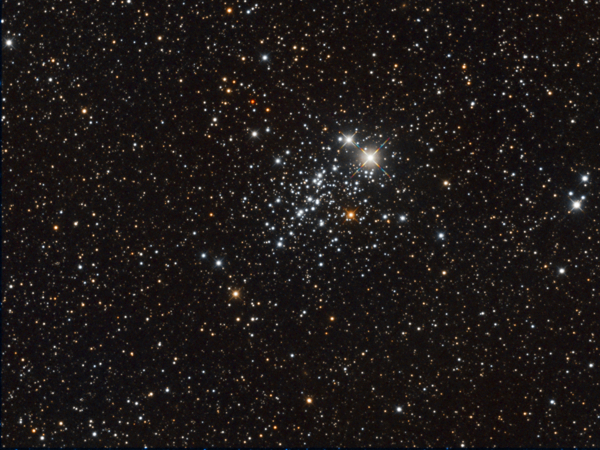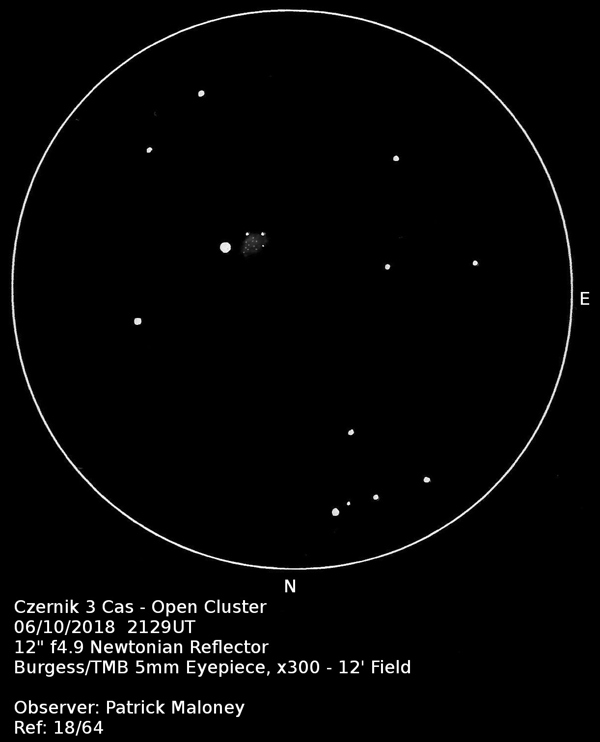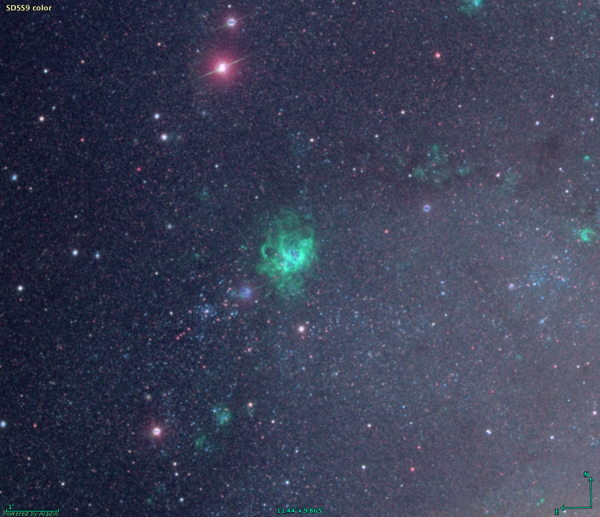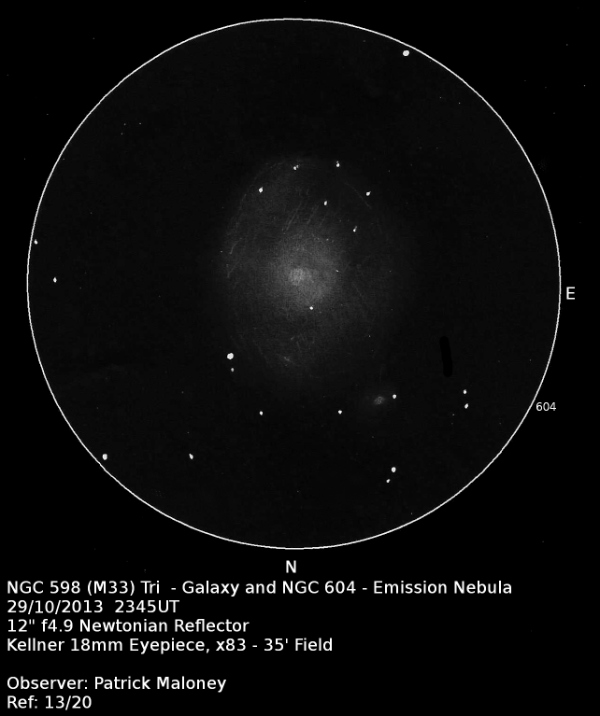NGC 457 and Cz 3 in Cassiopeia and NGC 604 in Triangulum
October 2020 - Nebula and Cluster of the Month
This month we’ll again be looking at three different objects. Each of these objects presents a different observing challenge.
We’ll start with this month’s first open cluster – NGC 457 in Cassiopeia. From the UK, this cluster is almost at the zenith at midnight in mid-October, so for those of you with Dobsonian-mounted telescopes, that in itself is something of a challenge! Good binoculars will show the cluster, and it’s easy to find, being attached to the 5th magnitude star φ (phi) Cas.

Phi Cas itself is a multiple star. It has five components, labelled A-E. Phi Cas (sometimes referred to as phi-1 Cas) is the brightest at magnitude 5.0, with component C (sometimes referred to as phi-2 Cas) the second brightest at magnitude 7. These two stars are well separated, being about 2.2' apart. They are the brightest stars in the field of NGC 457.
Is the phi Cas system actually part of NGC 457? This is a much-debated point. The two main stars far outshine the other members of the cluster, and phi-1 is an extremely luminous F5-type star, very close to being categorised as a yellow hypergiant. Its luminosity exceeds 100,000 suns. Phi-2 is a more regular, B5-type supergiant. The proper motion of the two supergiants is close to that of the other cluster members, and the parallax from Gaia data is broadly the same as that of cluster members. So phi is very close, spatially, to NGC 457, but the massive difference between the phi stars and the true members of the cluster usually tilt the balance of belief away from genuine membership.
NGC 457 itself was discovered by William Herschel on 18th October 1787. He described it as A brilliant cluster of large and very small stars. Considerably rich
. He placed it in his class VII – Pretty much compressed clusters of large or small stars – as no. 42.
NGC 457 lies around 2400pc (7800 light-years) away. It’s a fairly young cluster, its age being estimated at 21 million years. Its Trumpler classification is II3r (detached, slight concentration, bright and faint stars, rich). Archinal & Hynes give the membership as 204 stars, though the Deep-Sky Field Guide to Uranometria gives 80. The brightest star (ignoring the two phi stars) is V466 Cas, an M-type variable star of unknown type. It varies by about 0.08 of a magnitude and is around magnitude 8.6.
This is a lovely open cluster in almost any sized instrument. Its diameter is around 15 – 20’ and so requires only moderate magnification. My own observation of it, made with a 12” (305mm) Newtonian reads as follows: A visually striking, elongated cluster, dominated by 5th magnitude φ Cas and to a lesser extent by magnitude 7 SAO 22187 next to it. These two stars lie to the south-east of the cluster which stretches away north-west for about 20'. Two straggly arms of stars lead away from the body of the cluster south-west and north-east. Very well detached with a wide range of magnitudes, many bright, some very faint. About 80 stars were seen across about 20'. Nice.

Our second cluster could not present much more of a contrast. Czernik 3 lies 5° north-north-west of NGC 457, just the other side of Cassiopeia’s ‘wonky W’. This open cluster is very old and well into the process of disintegration. A recent study (Saurabh Sharma et al, 2020) has determined that the distance to the cluster is 3.5±0.9 kpc (8500–14300 light-years) and its age is around 0.9Gyr. The study found that the cluster was highly elongated (0.5x1.2pc) and 45 members were identified from Gaia data. It is believed that this is a rump cluster, with several, maybe even most, of its members already scattered.
Visually, it is not very prepossessing but presents an interesting challenge. Archinal & Hynes give a combined visual magnitude of 9.9, which I find to be hopelessly optimistic. In my 12” reflector, it is difficult to see. One or two very faint stars can be seen on the edge of a tiny patch of indistinct twinkles. The stars that were definitely seen were magnitudes 14.2 – 14.5. To the north-west of the cluster is an 11th magnitude star, which is clearly a foreground object.
The final offering for this month is an HII emission nebula, one of the largest known. It is NGC 604, and it lies within the galaxy M33 in Triangulum. This massive complex is over 1500 light-years in diameter (over 100 times the size of the visible region of the Orion Nebula, M42). It shines more than 6000 times brighter than the Orion Nebula, which is why, even at 2.7 million light-years distance, it is still readily visible in amateur telescopes.

NGC 604 was first noted as a discrete object by William Herschel, who discovered it on 11th September 1784, describing it as Near V.18. Very faint. Small. Round. Brighter in the middle.
The reference to ‘V.18’ is to the 18th entry in his class of ‘large nebulae’. This is surely a mistake. V.18 is now referred to as NGC 205 or M110, the satellite galaxy of M31 in Andromeda. The entry should probably read Near V.17…
as V.17 is M33.
By the time the object was included in the NGC in 1888, the description had been updated to Bright, very small, round, very, very little brighter towards the middle
.
NGC 604 lies 11’ north-east of the nucleus of M33. For most of us living under urban or suburban skies, this places it outside the visible region of M33 itself. Under such conditions, it looks for all the world like a smaller, fainter field galaxy. Whilst it is very difficult to give meaningful magnitudes for emission nebulae as a whole, with NGC 604 being so compact and galaxy-looking, I would estimate its magnitude at about 11.5.
Under excellent conditions, I have seen it with a 4½” (113mm) reflector. When I made that particular observation (way back in 1979) I hadn’t recognised NGC 604 for what it was, but when I wrote up the observation and checked the stars I had plotted, I found one which did not coincide with a star, but it did coincide with NGC 604.
Below is a later observation, showing NGC 604 masquerading as a field galaxy.

| Object | RA | Dec | Type | Magnitude |
|---|---|---|---|---|
| NGC 457 | 01h 19m 33s | +58° 17’ 00” | Open cluster | 6.4 |
| Cz 3 | 01h 03m 09s | +62° 47’ 03” | Open cluster | 9.9(?) |
| NGC 604 | 01h 34m 33s | +30° 47’ 00” | Emission nebula | about 11.5 |